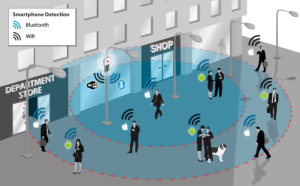What is a footfall? Why might a company want to understand it? Where is people counting most applicable? Managing and analyzing the flow of people can unlock new insights for your business, from where to expand and how to schedule staff to merchandising decisions, better store layout, and ensuring a better customer experience. Learn more about how Solink can help keep your business efficient.
In this guide, we look at everything a brick-and-mortar business might want to know about people counting and traffic counting.
To see how Solink can utilize your security cameras for people counting, sign up for a demo today.
Footfall data, also known as foot traffic or people counting, refers to the number of people entering and leaving a building (usually a retail outlet or shop) during a particular time frame.
It might seem like a strange thing to track—if you’re busy, you’re busy, and if you’re quiet, you’re quiet, right? However, digging deeper to understand footfalls can offer valuable, actionable insights to improve the bottom line of your business.

People counting vs. traffic counting
People counting and traffic counting are very similar concepts. Here are the definitions of people counting and traffic counting from the Solink Glossary:
- People counting, or footfall counting, is counting the number of people, usually with automated technology such as AI cameras or turnstiles, entering or exiting a location to understand things like conversion rates or the effectiveness of your advertising.
- Traffic counting is recording the number of vehicles, usually with automated technology such as AI cameras, entering or exiting a location to understand things like conversion rates or drive-thru speed of service.
Essentially, traffic counting is the same process as people counting but for cars. For a quick service restaurant (QSR) with a drive-thru, both people counting and traffic counting are important.
What metrics can you calculate with footfalls?
Businesses are increasingly looking to track their data in new ways in the hopes of unlocking novel business insights. This is a major reason people look to Solink, which connects video to other data sources, such as the point of sale (POS).
Solink can now use video cameras to perform people counting. This gives businesses even more understanding into how revenue is generated in their business.
Here are just five types of metrics that footfalls can help brick-and-mortar businesses measure:
- Conversion rates
- Speed of service
- Average revenue per visitor
- Average duration of visit
- Heatmaps and zone counting
Conversion rates
Conversion rates tell you what percentage of a population performed the action you want them to. For many businesses, a conversion can be defined as a visitor making a purchase. By tracking footfalls, you can see which percentage of people entering your business convert into a paying customer.
Speed of service
Speed of service is a critical metric as faster service means more orders processed per hour. That directly leads to higher revenue but also can mean more repeat customers. Faster service leads to better customer experience, and a better customer experience should result in more repeat business.
Many restaurants measure speed of service from the moment a customer orders, in-house or through the drive-thru, until the food is served and the bill is closed. However, people counting in-house and traffic counting in the drive-thru can allow you measure the full cycle speed of service from when a person arrives at your restaurant until they leave.
Average revenue per visitor
Restaurants usually have a good idea of the average revenue per visitor. However, bars and clubs where multiple bills are opened over a night by the same person or stores where not every visitor makes a purchase have a harder time understanding this important metric.
Footfall data helps businesses understand the average value of a visitor. This for example can give you insight into the effectiveness of your sales staff. If the value goes down, it might indicate your salespeople are being too passive and more people are leaving your store without making a purchase.
Average duration of visit
A business may be able to understand the average amount of time a visitor spends in a store or building. If you can connect longer visits to more conversions and/or better average revenue per visitor values, then this information can be used to train your sales staff to be more effective.
You could also design your store layout around maximizing the amount of time a visitor spends in your business.
Heatmaps and zone counting
Heatmaps and zone counting can demonstrate the typical occupancy of certain areas at any given time of day. This can help improve your sales.
To see how Solink can provide you with these business insights, sign up for a demo today.
Putting footfall data to work
Footfall data can inform a variety of business-related improvements, spanning everything from staffing to operations to marketing:
- Understand a location: People counting can inform how busy an area might be. As an example, this can be highly insightful information for malls providing traffic data to potential lenders.
- Enhance planning: Demand for business in many services may fluctuate dramatically. Retail, for example, sees regular spikes around the Christmas holiday period. The data generated by people counting can offer vital insights for anticipating seasonal changes in demand and planning marketing strategies accordingly.
- Manage occupancy capacity: Especially for popular bars and clubs, fire regulation capacity limits are important to enforce. Footfall counting technology can help protect you from expensive fines or nights missed from temporary closures.
- Strengthen loss prevention: Utilizing people counting technology throughout your business can help keep track of where people are going and how many people are in your business. This can help improve your loss prevention system.
- Locate shoplifters: When something goes missing within your store, using people counting security cameras to match foot traffic with video evidence of the product being removed from the shelf can help you spot shoplifters.
- Improve inventory management: Knowing how foot traffic in your business is changing day to day or even hour to hour can help you order better. You can use that information to order more or less based on real-time demand.
- Get a handle on organized retail crime (ORC): ORC raids are becoming a major part of retail theft. Counting footfalls can help you monitor the surges in foot traffic that can precede an ORC theft event. This is one of the ways to prevent external theft.
- Market more effectively: Using heatmaps and zone counting, companies may make informed decisions. Testing and determining where best to position their promotional and marketing materials using footfall data can help to maximize sales.
- Discover low- and high-demand hours: Optimize the number of staff during both busy and quiet periods to boost cost efficiency. You can also integrate footfall data into your exception-based reporting process to find unusually busy or quiet periods or troubling trends.
- Confirm all guests have paid:You can measure your sales numbers versus footfalls to confirm that fees are being collected from all guests. For example, a golf course can use people counting to make sure green fees are being paid by all golfers.
Few of these benefits will be realized overnight. To use footfall data effectively, it must be gathered over time.
How does Solink help with footfall analytics? Get in touch to know more.
How to measure footfalls
When it comes to exploiting the aforementioned benefits, it is often a case of “easier said than done.
Not so long ago, people counting was a manual process whereby an individual would use a hand tally. This method, however, has a number of drawbacks.
First, it requires a dedicated staff member to stand at an entrance point, the cost of which can be significant. Further, there is room for human error—what if the dedicated employee becomes distracted from what is a highly laborious and repetitive job or needs to vacate the vicinity to support a customer for a few minutes?
Thankfully, today there are easy-to-use, plug-and-play people counting systems that can help to calculate footfall.
Video camera detection counters
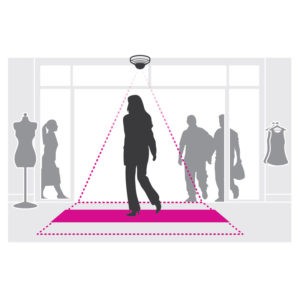
Video camera people counting is a recent technology, often coming in the form of facial recognition. These systems count all entrants just once and don’t rely on the presence of a WiFi/Bluetooth connected smartphone.
Solink has recently partnered with Hanwha to provide improved video footfall people counting.
They provide a number of benefits, making them some of the most successful people counting systems. In addition, they can be embedded within your video remote monitoring equipment, integrate with additional software to deliver improved ROI, offer even more advanced insights and analytics extending far beyond footfall, and leverage the power of AI and machine learning in some instances.
To see how Solink can provide people counting with security cameras, sign up for a demo today.
Wifi and Bluetooth counting
WiFi and Bluetooth counting are two of the more common technologies used to support foot traffic data collection systems. These systems tap into the WiFi and Bluetooth beacons on smartphones, capable of identifying the different MAC addresses to approximate foot traffic.
However, these systems are largely inaccurate. With the higher priority placed on privacy, WiFi and Bluetooth signals are often turned off, making people invisible to these sensors.
Turnstiles
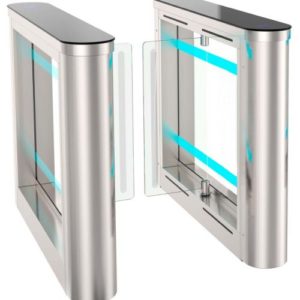
Turnstiles are the classic technology to automatically count footfalls. Turnstiles can incorporate mechanical people counting systems similar to that of hand tallies, yet avoid the issues associated with human error. However, the key challenge is that turnstiles are not customer friendly.
While they may work for certain businesses such as stadiums or sports centers, they do not for shops and stores where easy access takes precedence. Indeed, turnstiles are not to be recommended in these instances as they hamper convenience and counterproductively damage the customer experience.
Infrared counter
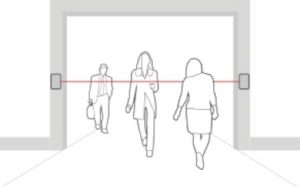
Infrared counters can be created using two pairs of infrared transceivers. When the first line is blocked, followed by a second line further into the store entrance, it counts an individual entering a building. If the opposite occurs, then it counts an individual exiting a building.
There are inaccuracies with these systems as well. Two people may walk into a store side by side, for example, and only count as one person. Likewise, if someone stands in the doorway, blocking the transceivers, then counting will be interrupted.
| People counting method | Pros | Cons |
| Wifi and Bluetooth counting |
|
|
| Video camera detection counting |
|
|
| Turnstiles |
|
|
| Infrared counting |
|
|
Who might benefit from counting footfalls?
Retail
A camera on the door connected to Solink’s platform can be used to count footfalls. Retail is one industry that stands to benefit significantly from footfall data through better understanding of customer demands, trends, and behaviors.
Using footfall insights, offerings and services can be adapted and reimagined to ensure the provision of an improved customer experience, optimized marketing efforts, maximized cost savings, bolstered sales, and more. Indeed, the benefits to be garnered from footfall systems align with the four key retail trends identified by KPMG in 2020.
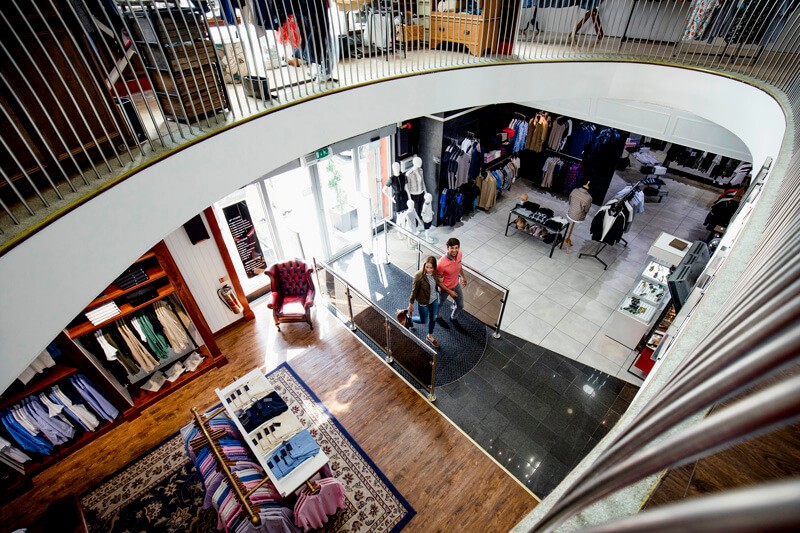
Beyond retail, people counting can also bring benefits to a variety of markets, catering to other sector-specific scenarios and helping businesses to realize real-world benefits in a multitude of ways.
Shopping malls
Shopping malls, for example, can use footfall data to understand which store fronts attract the most traffic and therefore provide more informed and logical rent prices over one-size-fits-all models.
Museums and galleries
Museums and galleries experiencing high visitor demand might use footfall systems to understand where overcrowding may be hampering customer experience and limit either the entire museum or certain areas/exhibitions to a specified number of people. This could in turn result in both the optimized deployment of staff and enhanced revenue opportunities through additional ticketing.
Public transport
Public transport hubs such as train stations, bus and coach stations, and airports can also evaluate footfall data to understand which services experience high demand and peak times. In doing so, they can optimize services by reducing the frequency offered during low demand periods and increasing them during busy hours.
Automobile Dealerships
Dealerships benefit from both people counting and traffic counting. Improving the time it takes for a salesperson to first interact with customers is one way that people counting can improve customer experience at a dealership. It could also help with merchandising by testing which cars at the front of the lot or in the showroom windows improves the number of footfalls.
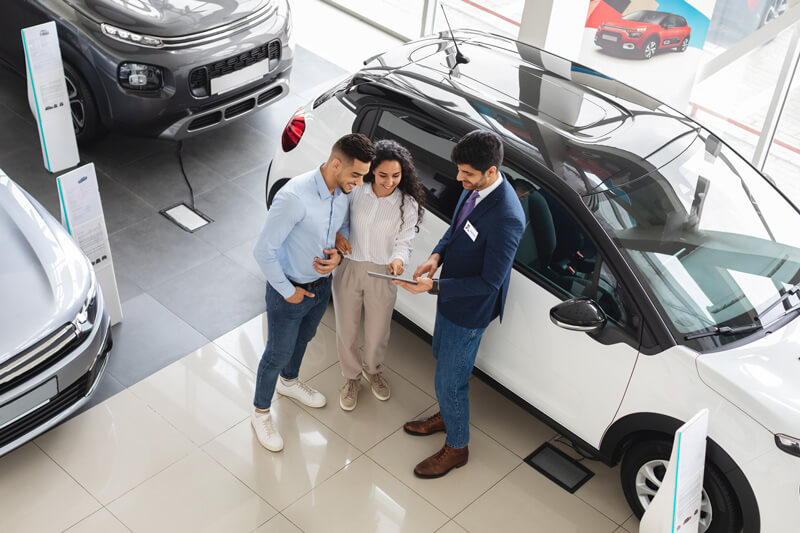
Theme Parks
Similar to museums and galleries, theme parks can experience customer bottlenecks, especially when a new attraction draws more visitors than the staple rides of the park. Using footfall data can help theme parks shift the flow of traffic away from the busiest rides or place strategic shops and snack vendors to improve profitability.
Bars and clubs
Bars and clubs need to closely track the number of customers entering and exiting to prevent fire code violations. It can also be difficult to calculate key metrics, such as the average revenue per visitor, without people counting. That’s because many visitors will open and close multiple bills throughout the night.
Convenience Stores
Convenience stores can use footfall data to make decisions about staffing or even hours of operation. If the convenience store has an attached gas station, then knowing the prevailing traffic levels can aid in decisions on expanding the number of pumps.
Restaurant
The major benefit of tracking footfalls for restaurants is improved staffing. In the long term, knowing the daily and weekly traffic trends can allow for better scheduling, which improves profitability. In the short term, registering sudden spikes in footfalls can be an indicator that the manager should try to call in more workers for a heavier than anticipated dinner rush.
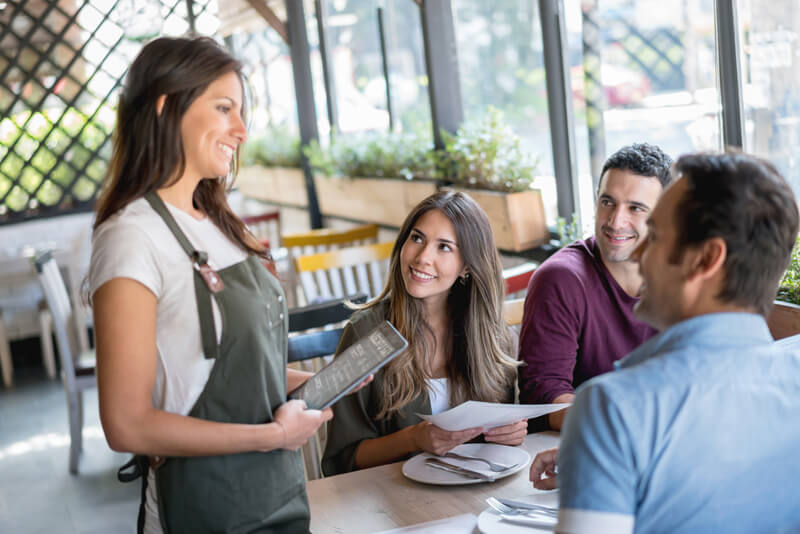
Hospitality
Hotels can better manage scheduling based on their footfall data. If there are swing staff members, reacting to sudden changes in footfalls through the main doors can get guests checked in and out more quickly.
Financial Institutions
Busy ATMs can make patrons uncomfortable. They need to type in a secret code and handle money, which can be nerve-wracking when there is a line up of people waiting. For the financial institution, that long line could result in people giving up and using a different ATM.
Tracking footfalls can help banks and credit unions place the right number of ATMs in the right locations with the right amount of cash inside to better serve their customers.
Similarly, branch services can be optimized based on footfall trends. Scheduling the right number of tellers throughout the week leads to both better customer service during peak hours and reduced labor costs caused by too many tellers working during off hours.
These are just a few examples. Footfall systems have many other potential use cases:
People counting FAQ
Here are some frequently asked questions about footfalls.
What are footfalls?
Footfalls are a measure of walking traffic in a location. Footfalls indicate the number of people walking by a location or entering a business.
How do footfall counters work?
There are many different types of footfall counters, including sensors, turnstiles, and cameras. They all work in different ways but follow the same principle. They count every time a person walks by the measured location.
How can I increase footfalls?
Increasing the number of footfalls requires increasing the number of people entering a location. There are many ways to increase the number of footfalls to your location, but they are all under the umbrella of marketing.
What does footfall analytics allow you to do?
Footfall analytics helps physical locations measure key business metrics. Here are just five types of metrics that footfalls can help brick-and-mortar businesses measure:
- Conversion rates
- Speed of service
- Average revenue per visitor
- Average duration of visit
- Heatmaps and zone counting
Why is footfall analysis important?
Footfall analysis gives businesses insight into how they are performing. Footfalls can tell businesses about their revenue generation and customer service quality, among many other things.
What can store managers do with footfall data?
Store managers can learn a lot about staffing through the use of people counting. Store managers can identify training needs, know when they may need to ask more employees to come in, and write better schedules.
What can area managers do with footfall data?
Area managers can measure how their locations are doing with footfall data. It is possible to see not just revenue trends but also why those trends are occurring. Area managers can also improve merchandising and ordering with the help of people and traffic counting.
What can the head office do with footfall data?
Head office can learn a lot about the quality of locations using footfall data. People and traffic counting can help make decisions about which locations to close or where new locations should be sited.
Headoffice can also improve loss prevention systems by recognizing unusual footfall data that may indicate organized retail crime (ORC) raids.
How should I perform people counting?
There are many different people counting systems, including sensors, turnstiles, and cameras. If your business already has security cameras, then camera-based footfall data collection is a cost effective and discreet people counting solution.
How does a camera count people?
Solink can count footfalls using security cameras. Artificial intelligence (AI) is used to measure motion through a business to count people entering and exiting a location.
How do you collect traffic data?
Solink can perform traffic counting using security cameras. Artificial intelligence (AI) is used to measure motion outside a business to count cars going through a specified area.
Unlock insights with footfall data
Footfall analysis is yet another example of data making a profound difference.
Businesses are already collecting data to help enhance operations and service. It’s just a matter of using the right analytical tools to find the right information, making smart changes, and tracking the success of your hard work.
We’re here to help.
Providing people counting systems and in-depth insight solutions such as heatmaps, our features offer you insight into daily business operations, regardless of time or location, in a way never before seen.
With intuitive video search and the system data to back it up, it’s never been easier to take action with confidence.
To pair data with video footage in Solink, sign up for a demo today.
